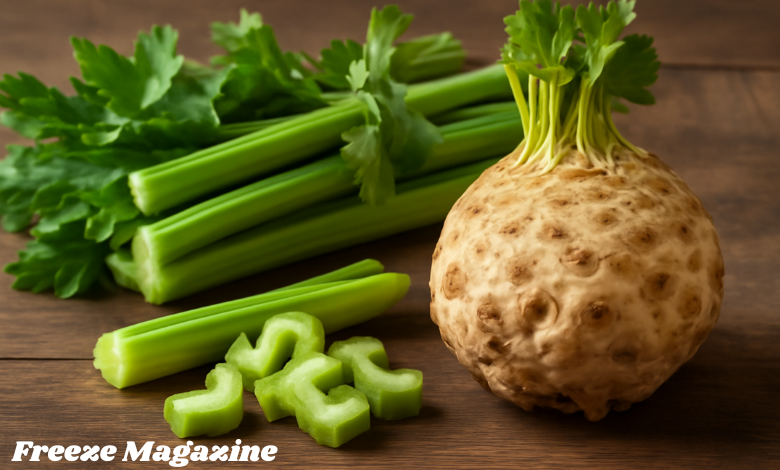Pravi Celer: The Authentic Celery with Rich Flavor and Incredible Health Benefits
Pravi celer is not just a vegetable; it’s a symbol of cultural heritage, rich in flavor, history, and nutrition. While it may resemble the common celery found in supermarkets, there’s much more to it than meets the eye. What sets pravi celer apart is its holistic use — encompassing both the stalk and the root, commonly known as celeriac. This deep connection to tradition and its unprocessed nature make it a standout in the culinary and wellness worlds, particularly in the Balkans and Slavic regions of Europe.
Origins and Varieties of Pravi Celer
Pravi celer is the traditional form of celery cultivated primarily in Eastern Europe, particularly in Slavic and Balkan countries. Unlike the celery you commonly find in Western supermarkets, which primarily uses the stalk, this variety includes both the stalk and the root, called celeriac. The root is an often overlooked part of the plant but offers a much richer and earthier flavor than the crisp stalks.
Pravi celer is often grown organically, ensuring that the vegetable remains as close to its natural form as possible. Minimal processing and alteration are the key to maintaining its authenticity, allowing the vegetable to retain its full flavor, nutrients, and medicinal properties.
Nutritional Profile and Health Benefits
Pravi celer is an incredibly nutritious vegetable that provides a range of health benefits. Here’s a breakdown of its key nutritional components:
1. Rich in Vitamins and Minerals
Pravi celer is a great source of several essential vitamins and minerals, including:
- Vitamin C: Known for its immune-boosting properties, Vitamin C in pravi celer helps to protect cells from damage and promotes skin health.
- Vitamin A: This vitamin supports eye health and boosts the immune system, playing a crucial role in vision and cellular growth.
- Potassium: Potassium helps in maintaining fluid balance and normal muscle and nerve function. It’s essential for heart health and blood pressure regulation.
2. Antioxidants and Anti-inflammatory Properties
The leaves, stalk, and root of pravi celer are rich in antioxidants like flavonoids and polyphenols. These compounds help in reducing inflammation and oxidative stress, which are associated with a variety of chronic diseases, including heart disease, diabetes, and cancer.
3. Digestive Health
The high fiber content in pravi celer supports healthy digestion by promoting regular bowel movements and preventing constipation. It’s also known to support gut health by encouraging the growth of beneficial gut bacteria.
4. Hydration
Being mostly water, pravi celer aids in hydration. The high water content helps to maintain moisture balance in the body, supports skin health, and can improve overall vitality.
5. Weight Management
Low in calories and high in fiber, pravi celer makes an excellent choice for those looking to maintain or lose weight. It helps promote feelings of fullness, preventing overeating and snacking between meals.
Culinary Uses of Pravi Celer
The versatility of pravi celer in the kitchen is one of the reasons why it’s considered so valuable in Slavic and Balkan cuisine. Both the stalk and root are used in a variety of dishes, and each part of the plant brings a unique flavor profile to the table.
1. Raw in Salads
Pravi celer is often sliced thinly and added to salads, where its crunchiness and slightly peppery taste add texture and depth.
2. Soups and Stews
Both the stalks and the root are commonly used in soups, stews, and broths. The root, with its earthy flavor, imparts a richness to the dish, while the stalks provide a fresh and zesty contrast.
3. Celeriac Mash or Puree
The root of the celery, or celeriac, is often boiled and mashed as an alternative to potatoes. This puree is creamy and savory, making it a perfect side dish.
4. Celery-Based Juices and Smoothies
Pravi celer can be used to make refreshing juices and smoothies, often combined with other vegetables and fruits for a nutrient-packed drink.
5. Herbal Teas and Remedies
The leaves and seeds of pravi celer can be steeped to create a herbal tea that is soothing and beneficial for digestion. In traditional medicine, celeric teas are believed to help with everything from detoxification to joint health.
Pravi Celer in Traditional Remedies and Beauty Treatments
In addition to its culinary uses, pravi celer holds a significant place in traditional remedies and beauty practices. In the Balkan and Slavic regions, it is often used as a natural treatment for various ailments.
1. Anti-inflammatory and Pain Relief
The anti-inflammatory properties of pravi celer make it an effective remedy for conditions such as arthritis and joint pain. Consuming the vegetable or applying its juice topically is believed to reduce swelling and provide relief from discomfort.
2. Skin Health
The high antioxidant content in pravi celer is beneficial for skin health. It is often used in natural beauty treatments to improve complexion, fight signs of aging, and maintain hydrated skin.
3. Detoxification
Pravi celer is also used for its detoxifying properties. Its natural diuretic effect helps flush out toxins from the body, promoting kidney health and overall detoxification.
Growing Pravi Celer
Pravi celer requires specific growing conditions to thrive. Here’s what you need to know about cultivating it:
- Climate: Celery is a cool-season vegetable that grows best in temperate climates. Avoid planting it during hot weather, as it can become tough and bitter.
- Soil: Pravi celer prefers well-drained, rich, and fertile soil. It thrives in soil that has a good amount of organic matter, which helps retain moisture and nutrients.
- Watering: Celery is a high-water plant that requires regular watering. Ensure that the soil remains consistently moist to prevent the plants from becoming stressed.
- Sunlight: While celery grows best in full sunlight, it can tolerate some partial shade, especially in hot climates.
If you’re growing it in your garden, expect to harvest it in about 3 to 4 months after planting.
Cultural Significance of Pravi Celer
Pravi celer has deep cultural roots in Eastern Europe, particularly in the Balkans and Slavic countries. Its use goes beyond culinary applications—it represents authenticity, purity, and a connection to traditional farming and cooking practices.
- Cultural Pride: For many, pravi celer is a symbol of authenticity. The holistic use of both the stalk and root represents a way of life that values sustainability and the preservation of natural food sources.
- Connection to the Land: Growing and harvesting pravi celer is tied to the land and seasonal cycles. It reflects the agricultural heritage of many European communities, where food is cherished not just for nourishment, but for its connection to the earth.
Conclusion
Pravi celer is more than just a vegetable. It embodies the essence of authenticity, tradition, and holistic use. Whether incorporated into everyday meals, used for medicinal purposes, or employed in beauty treatments, it serves as a reminder of the value of whole, unprocessed foods. Its rich history in Slavic and Balkan cultures underscores its importance, making it a culinary treasure that continues to thrive in modern kitchens around the world.




Post Comment